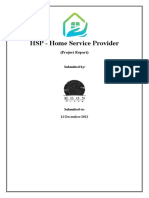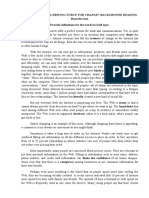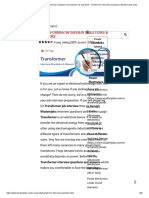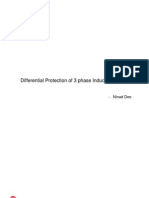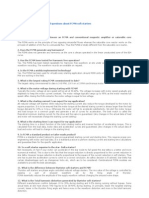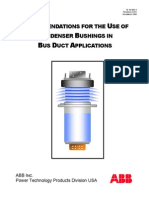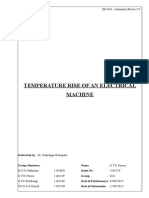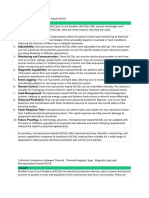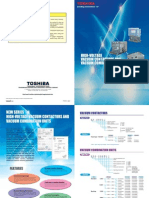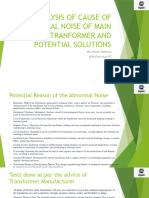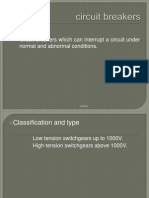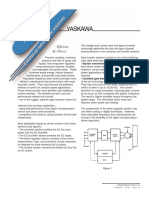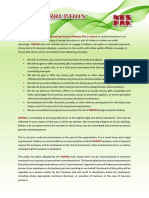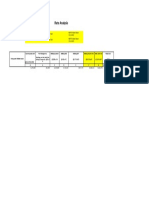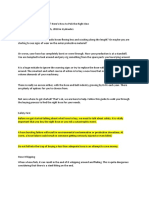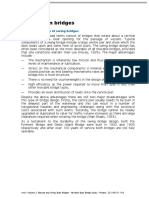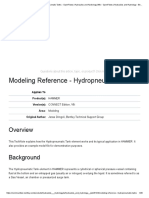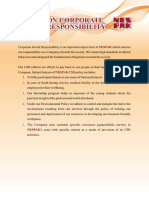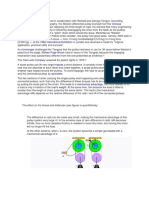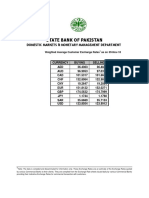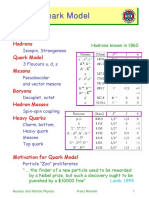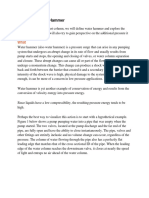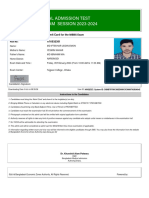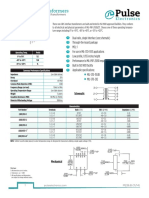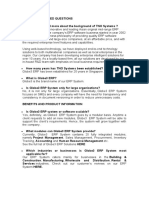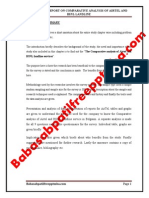Soft Starter Vs VFD
Soft Starter Vs VFD
Uploaded by
aqhammamCopyright:
Available Formats
Soft Starter Vs VFD
Soft Starter Vs VFD
Uploaded by
aqhammamOriginal Description:
Original Title
Copyright
Available Formats
Share this document
Did you find this document useful?
Is this content inappropriate?
Copyright:
Available Formats
Soft Starter Vs VFD
Soft Starter Vs VFD
Uploaded by
aqhammamCopyright:
Available Formats
Motors often require large amounts of energy when quickly accelerating to full
speed. Soft starters and variable frequency drives can both be used to reduce
inrush currents and limit torque protecting your valuable equipment and
extending the life of your motor by reducing motor heating caused by frequent
starts and stops.
When accelerating an AC motor to full speed using a full voltage connection, a large
inrush current may be required. Additionally, the torque of the AC motor is mostly
uncontrolled and can shock the connected equipment, potentially causing damage.
Variable Frequency Drives and Reduced Voltage Soft Starters can both be
used to reduce inrush currents and limit torque; thereby protecting
expensive equipment and extending the life of the motor and coupling
devices.
Soft starters
A reduced voltage soft starter helps protect the motor and connected
equipment from damage by controlling the terminal voltage. This limits the
initial inrush of current and reduces the mechanical shock associated with motor
startup and provides a more gradual ramp up to full speed. By gradually increasing
the motor terminal voltage the soft starter produces a more regulated motor
acceleration up to full speed.
Soft starters are used in applications where:
Speed ramping and torque control are desired when starting or stopping
High inrush currents associated with starting a large motor need to be limited to
avoid supply network issues or penalty charges
A gradual controlled starting is needed to avoid torque spikes and tension in the
mechanical system associated with normal equipment startup (e.g., conveyors, beltdriven systems, gears, couplings, etc.)
Avoiding pressure surges or hammering in piping systems when fluid changes
speed too rapidly.
Variable frequency drives
A variable frequency drive (VFD) is a motor control device that protects and
controls the speed of an AC induction motor. A VFD can control the speed of the
motor during the start and stop cycle, as well as throughout the run cycle.
Variable frequency drives are used in applications where:
Complete speed control is required
Energy savings is a goal
Custom control is needed
Variable frequency drives offer the greatest energy savings for fans and pumps. The
adjustable flow method changes the flow curve and drastically reduces power
requirements. While a variable frequency drive can be more expensive initially, they
can provide energy savings of up to 50 percent, therefore providing operating cost
savings over the life of the equipment.
You might also like
- How To Design Better UI Components 3.0 Full EbookDocument197 pagesHow To Design Better UI Components 3.0 Full EbookAbdul ahad Baloch100% (12)
- Masterguard C S Series FaultsDocument5 pagesMasterguard C S Series Faultsvayyik100% (1)
- The Technology of Instrument Transformers: Current and Voltage Measurement and Insulation SystemsFrom EverandThe Technology of Instrument Transformers: Current and Voltage Measurement and Insulation SystemsNo ratings yet
- XantiaDocument310 pagesXantiaΜιχάλης Χρυσουδάκης0% (1)
- Home Service ProviderDocument18 pagesHome Service ProviderghostNo ratings yet
- IEEE - STD C57.12.90-2010 CONVERSION 50-60HZDocument5 pagesIEEE - STD C57.12.90-2010 CONVERSION 50-60HZTXEMANo ratings yet
- Difference Between FCAPS and OAM&PDocument8 pagesDifference Between FCAPS and OAM&Ptanvir100% (1)
- The Internet Is A Driving Force For ChangeDocument2 pagesThe Internet Is A Driving Force For ChangeСветлана ЖдановаNo ratings yet
- Introduction About VFDDocument3 pagesIntroduction About VFDHuzaifa WasimNo ratings yet
- Motor Starting With Soft Starters - Reduced StressesDocument2 pagesMotor Starting With Soft Starters - Reduced StressesBachir GeageaNo ratings yet
- Surge Arrester SizingDocument3 pagesSurge Arrester Sizingoadipphone7031100% (1)
- Slip Ring Motor Liquid Resistor Soft Starting System (HV-LRS) PDFDocument4 pagesSlip Ring Motor Liquid Resistor Soft Starting System (HV-LRS) PDFLouie FernandezNo ratings yet
- Electrical Design Known TopicsDocument8 pagesElectrical Design Known TopicshaafilismailNo ratings yet
- Application of Multi-Function Motor Protection Relays To Variable Frequency Drive Connected MotorsDocument13 pagesApplication of Multi-Function Motor Protection Relays To Variable Frequency Drive Connected Motorslarry vargas bautistaNo ratings yet
- Transformer Interview Questions & Answers: Search For Jobs..Document29 pagesTransformer Interview Questions & Answers: Search For Jobs..shamshadNo ratings yet
- Differential Protection of 3 Phase Induction MotorsDocument15 pagesDifferential Protection of 3 Phase Induction Motorsoohcky100% (3)
- Upf MythDocument3 pagesUpf MythgurbachansainiNo ratings yet
- P225 PDFDocument12 pagesP225 PDFdave chaudhuryNo ratings yet
- Fcma FaqDocument2 pagesFcma FaqSusovan ParuiNo ratings yet
- Instruction Sheet DVCAS EN-SCH 25ka1sDocument49 pagesInstruction Sheet DVCAS EN-SCH 25ka1sdavid23281dNo ratings yet
- Seal of BushingDocument6 pagesSeal of BushingB.k. BirtiaNo ratings yet
- Power Quality AnalysisDocument17 pagesPower Quality Analysis18-208 Linga100% (1)
- High Voltage FuseseDocument28 pagesHigh Voltage Fusesezbyszko201234No ratings yet
- Nec 250 Part VIII DirectDocument12 pagesNec 250 Part VIII Directvladimir rosas ayalaNo ratings yet
- Temperature Rise of Electrical MachinesDocument9 pagesTemperature Rise of Electrical MachinesSandun HasankaNo ratings yet
- (LS) LV SWGR Power Center e 1304 1Document20 pages(LS) LV SWGR Power Center e 1304 1Wonbae ChoiNo ratings yet
- Role of Cooling On MV Motor DesignDocument5 pagesRole of Cooling On MV Motor DesignSUBRATA BISWASNo ratings yet
- Power Factor Testing of Power Distribution TransformersDocument8 pagesPower Factor Testing of Power Distribution TransformersfvicunaeNo ratings yet
- Drop Out Fuse ElementDocument2 pagesDrop Out Fuse ElementBalamurugan ArumugamNo ratings yet
- Device Number Definition and Function: 1-1 Master ElementDocument6 pagesDevice Number Definition and Function: 1-1 Master ElementHamayoun MurtazaNo ratings yet
- Microprocessor Based MCCBDocument3 pagesMicroprocessor Based MCCBanirban 007100% (2)
- 3 High Voltage SwitchgearDocument2 pages3 High Voltage SwitchgearriogadNo ratings yet
- Why Star Delta Starter Is Preferred With Induction MotorDocument4 pagesWhy Star Delta Starter Is Preferred With Induction MotorsujithNo ratings yet
- Autochangeover in Power PlantsDocument18 pagesAutochangeover in Power PlantsSukant BhattacharyaNo ratings yet
- Circuit BreakerDocument12 pagesCircuit BreakerHarshalPanchal100% (1)
- Percentage ImpedanceDocument2 pagesPercentage ImpedanceMahendra Pratap SinghNo ratings yet
- Starters For Centrifugal Chillers: Installation, Operation and Maintenance ManualDocument56 pagesStarters For Centrifugal Chillers: Installation, Operation and Maintenance ManualMuhammad Javed BhattiNo ratings yet
- Deep Bar Vis-À-Vis Double Cage Rotor Design For Large MV MotorsDocument2 pagesDeep Bar Vis-À-Vis Double Cage Rotor Design For Large MV MotorsSUBRATA BISWASNo ratings yet
- SIMOCODE Pro Presentation For SIMODODE - DP CustomersDocument40 pagesSIMOCODE Pro Presentation For SIMODODE - DP Customersronisatria08No ratings yet
- Fuse Contactor Selection - 6.6kVDocument10 pagesFuse Contactor Selection - 6.6kVapmanungadeNo ratings yet
- 400 KV Metal Oxide Surge Arrestor CigreDocument12 pages400 KV Metal Oxide Surge Arrestor CigreDilip ARNo ratings yet
- 4.4. Induction Motor Testing: 4.4.1. Routine TestsDocument8 pages4.4. Induction Motor Testing: 4.4.1. Routine TestsMurina AfifahNo ratings yet
- Analysis of Cause of Abnormal Noise of Tr-1Document11 pagesAnalysis of Cause of Abnormal Noise of Tr-1Mosiur RahmanNo ratings yet
- Sample Busduct SpecsDocument15 pagesSample Busduct SpecsONILEDA1970No ratings yet
- Circuit BreakersDocument48 pagesCircuit BreakerspitambervermaNo ratings yet
- Why PS Class CT Is Used For Diffenential ProtectionDocument3 pagesWhy PS Class CT Is Used For Diffenential Protectionkajale_shrikant2325No ratings yet
- NGRDocument3 pagesNGRThirunavukkarasu VaratharajanNo ratings yet
- 250 Kva 20.01Document5 pages250 Kva 20.01Hemant PanpaliyaNo ratings yet
- Using Core-Balance Current Transformer For Earth Fault Protection - EEPDocument2 pagesUsing Core-Balance Current Transformer For Earth Fault Protection - EEPcatalinccNo ratings yet
- Product Catalogue BatteryDocument24 pagesProduct Catalogue BatteryPrakash SinhaNo ratings yet
- Earth Fault RelayDocument52 pagesEarth Fault RelayAgung MohamadNo ratings yet
- Technical Specification: EctionDocument22 pagesTechnical Specification: EctionmlutfimaNo ratings yet
- 8.I-11 KV Xlpe CablesDocument5 pages8.I-11 KV Xlpe CablesAnkur SinhaNo ratings yet
- IS 2705 NotesDocument12 pagesIS 2705 NotesPhani KumarNo ratings yet
- NGR Value CalculationDocument1 pageNGR Value Calculationsanjeev267No ratings yet
- 132KV 2 Line Metering PanelDocument11 pages132KV 2 Line Metering PanelUsman RasheedNo ratings yet
- Motor ProtectionDocument33 pagesMotor ProtectionMohamed RashidNo ratings yet
- Transformer SpecificationDocument4 pagesTransformer SpecificationMhd MouffakNo ratings yet
- Motor StartersDocument4 pagesMotor Starterssui1981No ratings yet
- Overhead LinesDocument33 pagesOverhead LinesxolraxNo ratings yet
- Soft Starter Vs VFDDocument15 pagesSoft Starter Vs VFDMitesh GandhiNo ratings yet
- Efficient AC Drives: Yaskawa Electric America, IncDocument4 pagesEfficient AC Drives: Yaskawa Electric America, IncRajashekar LokamNo ratings yet
- Anti-Corruption Anti-Corruption Policy PolicyDocument1 pageAnti-Corruption Anti-Corruption Policy PolicyaqhammamNo ratings yet
- Rate Analysis: 1 199.5 PKR 1 $ 175.95 PKR NBP FX Rate Sheet 15.2.2022 NBP FX Rate Sheet 15.2.2023Document1 pageRate Analysis: 1 199.5 PKR 1 $ 175.95 PKR NBP FX Rate Sheet 15.2.2022 NBP FX Rate Sheet 15.2.2023aqhammamNo ratings yet
- Calculating Recommended Hose Diameter in A Hydraulic Circuit - FlowfitDocument3 pagesCalculating Recommended Hose Diameter in A Hydraulic Circuit - FlowfitaqhammamNo ratings yet
- Selecting The Correct Hydraulic Oil - Hydraulics & PneumaticsDocument5 pagesSelecting The Correct Hydraulic Oil - Hydraulics & PneumaticsaqhammamNo ratings yet
- RG Group ArticleDocument4 pagesRG Group ArticleaqhammamNo ratings yet
- Viscosity of Hydraulic OilDocument2 pagesViscosity of Hydraulic OilaqhammamNo ratings yet
- Moveable Span Bridge Study Volume 2 Bascule and Swing Span Bridges Part 2 PDFDocument54 pagesMoveable Span Bridge Study Volume 2 Bascule and Swing Span Bridges Part 2 PDFaqhammam100% (1)
- HEALTHDocument1 pageHEALTHaqhammamNo ratings yet
- Rate Analysis of Super StructureDocument8 pagesRate Analysis of Super StructureaqhammamNo ratings yet
- Hydropneumatic Tanks - OpenFlowsDocument28 pagesHydropneumatic Tanks - OpenFlowsaqhammamNo ratings yet
- Rate Analysis of Super StructureDocument8 pagesRate Analysis of Super StructureaqhammamNo ratings yet
- Policy On Corporate Social Responsibility Social Responsibility (CSR) (CSR)Document1 pagePolicy On Corporate Social Responsibility Social Responsibility (CSR) (CSR)aqhammamNo ratings yet
- Rate Analysis: Detail Unit 100 KG Unit Qty Rate Per UnitDocument8 pagesRate Analysis: Detail Unit 100 KG Unit Qty Rate Per UnitaqhammamNo ratings yet
- Clay Dib Rell 2002Document10 pagesClay Dib Rell 2002aqhammamNo ratings yet
- Chain PulleyDocument3 pagesChain PulleyaqhammamNo ratings yet
- Causes of Water HammerDocument6 pagesCauses of Water HammeraqhammamNo ratings yet
- Foreign Exchange MarketDocument20 pagesForeign Exchange MarketaqhammamNo ratings yet
- SBP Rate Sheet 09 Nov 2018Document1 pageSBP Rate Sheet 09 Nov 2018aqhammamNo ratings yet
- Quarks ModelDocument12 pagesQuarks ModelaqhammamNo ratings yet
- Chan 1999Document16 pagesChan 1999aqhammamNo ratings yet
- Causes of Water HammerDocument8 pagesCauses of Water HammeraqhammamNo ratings yet
- AdmitCard HWQZSZDocument1 pageAdmitCard HWQZSZsparky.if710No ratings yet
- MIL-STD-1553 Transformers: SchematicDocument2 pagesMIL-STD-1553 Transformers: SchematicSalman ShahNo ratings yet
- CHAPTER 1 - History of Kaizen & Lean ManagementDocument8 pagesCHAPTER 1 - History of Kaizen & Lean Managementsam100% (1)
- Net Tech Shop Customer Information Sheet/Work Order: Customers Please Read and SignDocument1 pageNet Tech Shop Customer Information Sheet/Work Order: Customers Please Read and Signevie6410No ratings yet
- Toshiba Satellite S55T-A5132Document4 pagesToshiba Satellite S55T-A5132James MedinaNo ratings yet
- Router On A StickDocument5 pagesRouter On A SticksreenathonwebNo ratings yet
- Hoshin Kanri SampleDocument8 pagesHoshin Kanri SampleMariapaula Castellanos MahechaNo ratings yet
- SSL TCLDocument22 pagesSSL TCLdwnldmeNo ratings yet
- Kisi Kisi URSDocument32 pagesKisi Kisi URSitung23No ratings yet
- 3 Mobile Phones To Keep Your Eyes On in Daraz Mobile WeekDocument7 pages3 Mobile Phones To Keep Your Eyes On in Daraz Mobile WeekAbhishek AcharyaNo ratings yet
- Week 1 PDFDocument27 pagesWeek 1 PDFAmanullah AslamNo ratings yet
- Living in The IT Era Prelims (28 - 30)Document3 pagesLiving in The IT Era Prelims (28 - 30)Mark Errol75% (4)
- 3rd Party Access Control Integration With KONE DCS Communication Example...Document9 pages3rd Party Access Control Integration With KONE DCS Communication Example...deaironiNo ratings yet
- Overview Data Sheets: Relay in Terminal Block Case H 4116Document2 pagesOverview Data Sheets: Relay in Terminal Block Case H 4116mohamadziNo ratings yet
- Nav 2-SP-F-001Document18 pagesNav 2-SP-F-001Shenly MarquezNo ratings yet
- Model Questions GIS RS 2078Document2 pagesModel Questions GIS RS 2078Sujan PandeyNo ratings yet
- Globe3 - FAQDocument3 pagesGlobe3 - FAQGlobe3 ERPNo ratings yet
- Pitch Deck - Copilot For Microsoft 365Document20 pagesPitch Deck - Copilot For Microsoft 365YéYé BassNo ratings yet
- Angelos Raftopoulos PF 2023Document38 pagesAngelos Raftopoulos PF 2023raftopouaNo ratings yet
- Sonicwall™ Nsa 2600/3600/4600/5600/6600: Getting Started GuideDocument63 pagesSonicwall™ Nsa 2600/3600/4600/5600/6600: Getting Started GuideTarun BhatnagarNo ratings yet
- A Project Report On Comparative Analysis of Airtel and BSNL Landline Executive SummaryDocument87 pagesA Project Report On Comparative Analysis of Airtel and BSNL Landline Executive SummaryvishalniNo ratings yet
- Conducting An Incident Response Investigation 4e - Tamirah WilliamsDocument15 pagesConducting An Incident Response Investigation 4e - Tamirah Williams007503711No ratings yet
- Android ScainDocument28 pagesAndroid ScainSaprinus SapNo ratings yet
- Draughtsman Civil: Redesigned in 2014 byDocument27 pagesDraughtsman Civil: Redesigned in 2014 byirshadNo ratings yet




